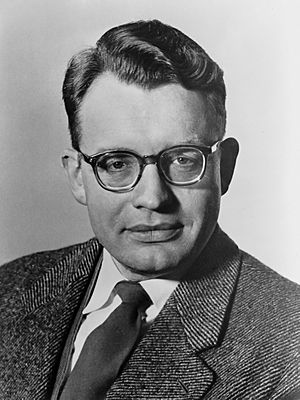Hendrik Casimir facts for kids
Quick facts for kids
Hendrik Casimir
|
|
|---|---|

Casimir in 1958
|
|
| Born | 15 July 1909 The Hague, Netherlands
|
| Died | 4 May 2000 (aged 90) Heeze, Netherlands
|
| Alma mater | University of Leiden |
| Known for | Casimir effect Casimir invariant Casimir pressure |
| Awards | Wilhelm Exner Medal (1982) Matteucci Medal (1985) |
| Scientific career | |
| Fields | Physics |
| Institutions | University of Leiden Philips Natuurkundig Laboratorium |
| Doctoral advisor | Paul Ehrenfest |
| Notable students | Carolyne Van Vliet |
Hendrik Brugt Gerhard Casimir (born July 15, 1909 – died May 4, 2000) was a brilliant Dutch physicist. He is most famous for his important work on how superconductors behave. He also helped discover the amazing Casimir effect, which explains a tiny force between objects.
Contents
Early Life and Studies
Hendrik Casimir was born on July 15, 1909, in The Hague, Netherlands. He loved learning about how the world works. He went to the University of Leiden to study theoretical physics. There, he learned from a famous professor named Paul Ehrenfest.
Casimir earned his Ph.D. in 1931. His research was about the quantum mechanics of spinning objects. He also spent time in Copenhagen with another very famous physicist, Niels Bohr. They even had some fun doing mock shoot-outs to help Bohr with a scientific idea!
Working with Top Scientists
From 1932 to 1933, Casimir worked with Wolfgang Pauli in Zurich. Pauli was a Nobel Prize winner. During this time, Casimir studied the relativistic theory of the electron. This is about how tiny electrons behave at very high speeds. He even invented some clever math tools to help with his work.
In 1938, Casimir became a physics professor at Leiden University. He studied how heat conduction and electrical conduction work. He also helped scientists reach incredibly cold temperatures, close to absolute zero.
Life at Philips
In 1942, during World War II, Casimir moved to the Philips Natuurkundig Laboratorium (Philips Physics Laboratory). This was a big research lab in Eindhoven, Netherlands. He continued his important scientific work there.
In 1946, he became a co-director of the Philips lab. Later, in 1956, he joined the company's board of directors. He retired from Philips in 1972. Even though he worked in industry, Casimir was still one of the most important Dutch theoretical physicists.
Key Discoveries and Contributions
Casimir made many important contributions to science between 1931 and 1950. These include:
- Working on pure mathematics and Lie groups.
- Studying the hyperfine structure of atoms.
- Researching low-temperature physics and magnetism.
- Understanding the thermodynamics of superconductors.
- Applying Lars Onsager's theory of irreversible phenomena.
The Casimir Effect
While at Philips, in 1948, Casimir worked with Dirk Polder. They predicted a strange quantum mechanical force. This force causes two uncharged, parallel conducting plates to attract each other. This tiny force is now known as the Casimir effect. It is very important in the design of tiny machines called Micro Electro-Mechanical Systems (MEMS).
Awards and Recognition
Hendrik Casimir received many honors for his work. He was given six honorary doctor degrees from universities around the world. He also won many awards and prizes, including the Wilhelm Exner Medal in 1982.
He was an elected member of several important scientific groups. These included the Royal Netherlands Academy of Arts and Sciences and the United States National Academy of Sciences. He also helped create the European Physical Society and was its president from 1972 to 1975.

